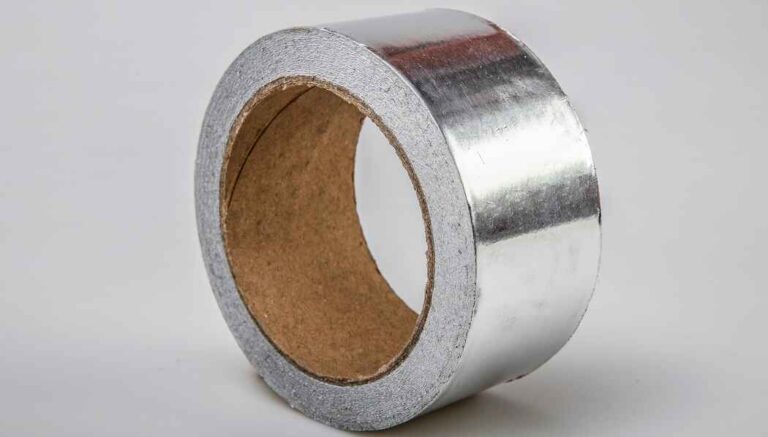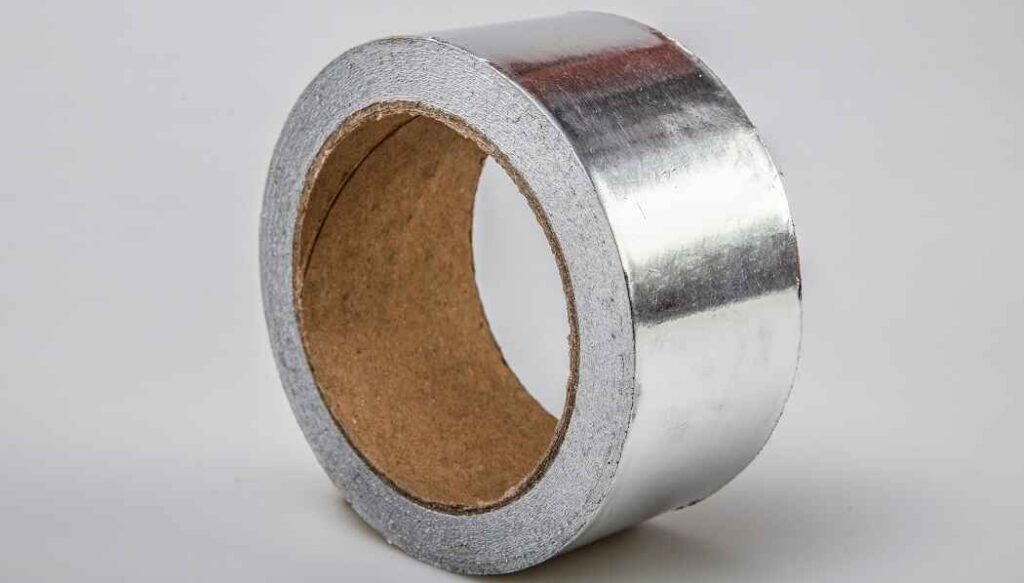
Can You Paint Aluminum Foil Tape? [A Comprehensive Guide]
If you’ve ever wondered whether aluminum foil tape can become your artistic canvas, the answer is an exciting ‘yes.’

Let’s discover invaluable tips and techniques on how to paint, design, and transform ordinary foil tape into captivating masterpieces.
Can You Paint Aluminum Foil Tape?
Yes, you can paint aluminum foil tape.
Aluminum foil tape is a versatile adhesive tape commonly used for sealing, patching, and repairing HVAC ducts, insulation, and other metal surfaces. If you want to change the tape’s appearance or match it with a specific color scheme, painting can be a suitable option.
Painting can also provide an extra layer of protection against environmental factors like oxidation and UV radiation, enhancing its longevity in certain situations. Additionally, painting can allow for customization, such as adding labels or markings on the tape.
However, there are situations where painting aluminum foil tape might not be advisable. If the tape is used for heat reflection or insulation purposes, painting it could reduce its effectiveness.
The adhesive properties of the tape are not affected by painting, but if the adhesive side needs to adhere to surfaces, it’s better to leave it unpainted to ensure proper adhesion. Moreover, if the tape serves its purpose effectively in its original state and there is no specific need for painting, it might not be necessary, saving time and resources.
What Kind of Paint Will Stick to Aluminum Foil Tape?
If you want to paint over aluminum foil tape for a specific reason, such as camouflaging it or integrating it into a project, you’ll need to select the appropriate type of paint to ensure good adhesion and durability.
Here are some paint options that can work well with aluminum foil tape:
Acrylic Paint: Acrylic paint is a versatile water-based paint that adheres reasonably well to many surfaces, including aluminum foil tape. It dries quickly and creates a durable, flexible finish. Make sure to clean the tape surface before applying the paint to remove any dirt, oil, or residue that might interfere with adhesion.
Tempera Paint: Tempera paint is another type of paint that can be used on aluminum foil tape. Tempera paint is water-based and known for its opaque and vibrant colors. It is often used in art and craft projects and can adhere reasonably well to various surfaces, including aluminum foil tape.
Latex Paint: Like acrylic paint, latex paint is also water-based and can adhere to aluminum foil tape effectively. It is commonly used for interior and exterior applications and offers good durability and flexibility.
Spray Paint: Spray paint, specifically designed for metal surfaces, can be a suitable option for painting aluminum foil tape. It provides an even and smooth finish when applied correctly, and many spray paints are compatible with metal surfaces.
Epoxy Paint: If you require a more robust and long-lasting paint finish, epoxy paint can be a good choice. Epoxy paint forms a strong bond with metal surfaces and provides excellent protection against moisture and chemicals.
Factors to Consider Before Painting Aluminum Foil Tape
Before painting aluminum foil tape, there are several factors to consider to ensure a successful and long-lasting paint job:
Surface Preparation: Properly prepare the surface by cleaning it thoroughly to remove any dirt, dust, grease, or other contaminants. This helps the paint adhere better to the tape’s surface.
Compatibility of Paint: Ensure that the paint you choose is compatible with both aluminum and adhesive materials. Some paints may not adhere well to certain types of adhesives or may react adversely with the aluminum surface.
Paint Type: Select the appropriate type of paint for the intended use. For example, if the tape will be exposed to outdoor conditions, consider using weather-resistant or outdoor-specific paint to protect against the elements.
Look for paints labeled as “metal paint” or “aluminum paint” to achieve the best results.
Adhesion Promoter: Depending on the paint and tape types, using an adhesion promoter or primer may be necessary to improve the bond between the paint and the tape’s surface.
Drying Time: Consider the drying time of the paint. If the tape is needed for immediate use after painting, choose a fast-drying paint to avoid smudging or sticking issues.
Temperature and Humidity: Check the recommended temperature and humidity range for the paint application. Extreme conditions may affect the paint’s drying and curing process.
Surface Texture: Take into account the texture of the tape’s surface. Some aluminum foil tapes may have a smooth or slightly rough surface, which can impact how the paint adheres and looks.
Paint Application Method: Choose an appropriate paint application method such as brush, roller, or spray. The method may affect the paint’s coverage and finish.
Number of Coats: Determine the number of paint coats needed to achieve the desired opacity and color intensity. Multiple thin coats are often better than a single thick coat.
Paint Curing Time: Allow sufficient time for the paint to fully cure before subjecting the tape to any stress or use.
Durability: Consider the tape’s intended use and environment. If the tape will be subject to frequent handling or exposure to harsh conditions, select a paint that offers good durability and resistance to wear and tear.
How to Paint Aluminum Foil Tape Successfully?
Painting aluminum foil tape can be a useful way to customize its appearance, provide additional protection, or make it blend in with other surfaces. To successfully paint aluminum foil tape, follow these steps:
Materials you’ll need:
- Aluminum foil tape
- Clean cloth or rag
- Mild detergent or rubbing alcohol
- Fine-grit sandpaper (optional)
- Primer (suitable for metal surfaces)
- Acrylic or enamel paint
- Paintbrushes (foam or bristle brushes work well)
- Painter’s tape (optional)
Step-by-step process:
1. Surface preparation:
- Before painting, ensure the aluminum foil tape is clean and free from any dirt, dust, or grease. Use a clean cloth or rag to wipe the surface gently.
- If the tape has adhesive residue or stubborn stains, you can clean it with mild detergent or rubbing alcohol. Allow it to dry completely before proceeding.
2. Optional: Sanding the surface (if needed):
If the tape has a glossy or smooth surface, you may want to lightly sand it with a fine-grit sandpaper. This step helps improve paint adhesion by creating a slightly roughened surface. After sanding, wipe away any dust with a clean cloth.
3. Applying primer (recommended):
- Applying a primer designed for metal surfaces is highly recommended, as it helps the paint adhere better and ensures a more even and durable finish.
- Stir the primer thoroughly before application, and then use a brush to apply a thin, even coat over the entire surface of the aluminum foil tape. Allow the primer to dry according to the manufacturer’s instructions.
4. Painting the tape:
- Once the primer is dry, you can start painting the aluminum foil tape.
- Choose a high-quality acrylic or enamel paint in your desired color. These types of paint adhere well to metal surfaces and provide good coverage.
- Stir the paint thoroughly before using, and then apply it to the tape with a brush. Use smooth, even strokes to avoid visible brush marks.
- Depending on the color and coverage, you may need to apply multiple coats of paint. Allow each coat to dry completely before applying the next one. Follow the paint manufacturer’s recommendations for drying times.
5. Optional: Adding designs or patterns (using painter’s tape):
- If you want to add designs or patterns to the painted aluminum foil tape, you can use painter’s tape to create clean lines and shapes.
- Apply the painter’s tape over the painted surface, following the desired pattern. Make sure the edges of the painter’s tape are firmly pressed down to prevent paint from seeping underneath.
- Paint over the exposed areas, and once the paint is dry, carefully remove the painter’s tape to reveal the design.
6. Final touches:
- After the paint has dried completely, inspect the painted aluminum foil tape for any imperfections or areas that may need touch-ups.
- If necessary, use a fine paintbrush to touch up any spots or add finer details.
7. Allow proper drying time:
Give the paint ample time to dry and cure fully before subjecting the tape to any stress or use. This duration may vary depending on the type of paint used, but it’s generally a few days.
Conclusion
In the end, painting on aluminum foil tape is not just an artistic experiment; it’s an invitation to think outside the box and challenge traditional notions of what can be used as a canvas. Embrace the unique characteristics of this medium and watch as your creativity flourishes. Happy painting!
